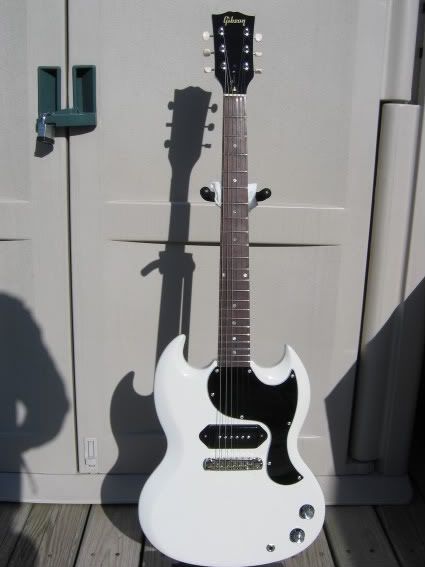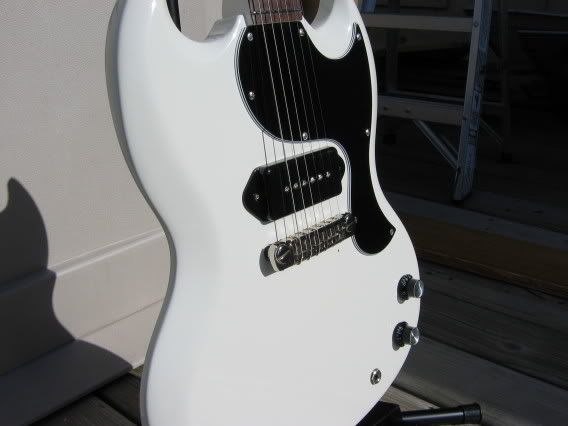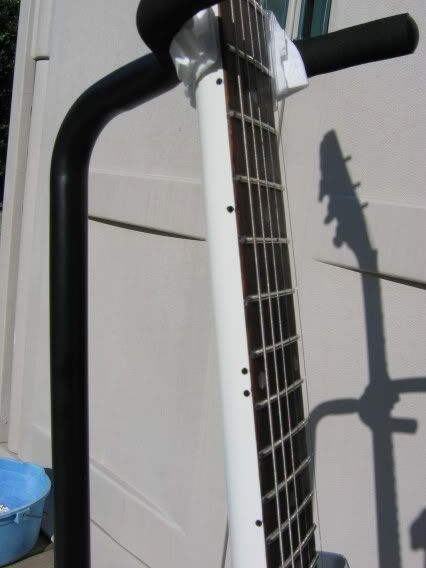Finally after two grueling months. A special thanks to all that made suggestions and recommendations, Sully, DonP, mm2002 and others! This is what makes this forum great! Thanks Again guy's!
I started with a 1965 SG Junior that was somewhat used and abused and had a bad refinish over the original Cherry. The guitar had a dozen tuner changes and the headstock was literally coming apart. It was splitting down the middle of the tuner holes! I decided with all the holes that needed to be plugged to go with the original lacquer finish they put on Gibsons in that era. I figured on a "Jake E. Lee" Polaris (PPG, Duracryl) white job. Then, I had to find the acrylic lacquer since it is sparsely available these days. I'm old school like Mark, but I tried the HVLP gravity guns and they worked out. Just remember to unplug the hole that fills with paint from time to time (It needs air). I had to figure I was going to have to wait till I buffed her out, with the slow curing time, but it was worth it. The guitar had no neck breaks or repairs, so I went ahead with the project. I plugged the tuner holes for re-drilling. It was tricky because I wanted to use the original Kluson nickel tuner ferrels. I decided on "Tonepros" Klusion vintage tuners. You have got to check these out they are awesome, no shaft wobble and the gear internals are Titanium. They feel like a locking tuner with the tight ratio. The headstock was veneered with mahogany and the back of the headstock epoxied. I used epoxy grain filler to seal the Mah. large grain. The fretboard had to be planed, sanded and refretted with Gibson fret wire. The frets were polished to a mirror finish, both on top and the fret ends after levelling and crowning. The fretboard was sealed with StewMac fretboard conditioning oil. (This was done after the primer stage) But, before I could paint the white, I had to replace the side position dots with black ones. I drilled out the cream ones and glued in the black. But, wait this is where it got interesting. I had to leave the black markers sticking out a few thousandth's so that when I paint to the necks' fretboard edge, I could sand and polish the paint and the side dots at the same time, thus levelling everything at the same time. The white SG Junior's in "white" were unique, in that the paint was to go all the way to the fretboards edge. I had to de-oil the rosewood on the edge so that the paint would stick!
(It needs air). I had to figure I was going to have to wait till I buffed her out, with the slow curing time, but it was worth it. The guitar had no neck breaks or repairs, so I went ahead with the project. I plugged the tuner holes for re-drilling. It was tricky because I wanted to use the original Kluson nickel tuner ferrels. I decided on "Tonepros" Klusion vintage tuners. You have got to check these out they are awesome, no shaft wobble and the gear internals are Titanium. They feel like a locking tuner with the tight ratio. The headstock was veneered with mahogany and the back of the headstock epoxied. I used epoxy grain filler to seal the Mah. large grain. The fretboard had to be planed, sanded and refretted with Gibson fret wire. The frets were polished to a mirror finish, both on top and the fret ends after levelling and crowning. The fretboard was sealed with StewMac fretboard conditioning oil. (This was done after the primer stage) But, before I could paint the white, I had to replace the side position dots with black ones. I drilled out the cream ones and glued in the black. But, wait this is where it got interesting. I had to leave the black markers sticking out a few thousandth's so that when I paint to the necks' fretboard edge, I could sand and polish the paint and the side dots at the same time, thus levelling everything at the same time. The white SG Junior's in "white" were unique, in that the paint was to go all the way to the fretboards edge. I had to de-oil the rosewood on the edge so that the paint would stick! Well, I managed to pull it off. I have never done anything like this before. The side dot material is very soft, almost the consistancy or hardness of the paint, so it made wet sanding rather easy. So any way, without further addo, here she is. Another added to the Jake collection and I didn't have to have a newspaper route to pay for her
Well, I managed to pull it off. I have never done anything like this before. The side dot material is very soft, almost the consistancy or hardness of the paint, so it made wet sanding rather easy. So any way, without further addo, here she is. Another added to the Jake collection and I didn't have to have a newspaper route to pay for her I'm beat!
I'm beat!





I started with a 1965 SG Junior that was somewhat used and abused and had a bad refinish over the original Cherry. The guitar had a dozen tuner changes and the headstock was literally coming apart. It was splitting down the middle of the tuner holes! I decided with all the holes that needed to be plugged to go with the original lacquer finish they put on Gibsons in that era. I figured on a "Jake E. Lee" Polaris (PPG, Duracryl) white job. Then, I had to find the acrylic lacquer since it is sparsely available these days. I'm old school like Mark, but I tried the HVLP gravity guns and they worked out. Just remember to unplug the hole that fills with paint from time to time
 (It needs air). I had to figure I was going to have to wait till I buffed her out, with the slow curing time, but it was worth it. The guitar had no neck breaks or repairs, so I went ahead with the project. I plugged the tuner holes for re-drilling. It was tricky because I wanted to use the original Kluson nickel tuner ferrels. I decided on "Tonepros" Klusion vintage tuners. You have got to check these out they are awesome, no shaft wobble and the gear internals are Titanium. They feel like a locking tuner with the tight ratio. The headstock was veneered with mahogany and the back of the headstock epoxied. I used epoxy grain filler to seal the Mah. large grain. The fretboard had to be planed, sanded and refretted with Gibson fret wire. The frets were polished to a mirror finish, both on top and the fret ends after levelling and crowning. The fretboard was sealed with StewMac fretboard conditioning oil. (This was done after the primer stage) But, before I could paint the white, I had to replace the side position dots with black ones. I drilled out the cream ones and glued in the black. But, wait this is where it got interesting. I had to leave the black markers sticking out a few thousandth's so that when I paint to the necks' fretboard edge, I could sand and polish the paint and the side dots at the same time, thus levelling everything at the same time. The white SG Junior's in "white" were unique, in that the paint was to go all the way to the fretboards edge. I had to de-oil the rosewood on the edge so that the paint would stick!
(It needs air). I had to figure I was going to have to wait till I buffed her out, with the slow curing time, but it was worth it. The guitar had no neck breaks or repairs, so I went ahead with the project. I plugged the tuner holes for re-drilling. It was tricky because I wanted to use the original Kluson nickel tuner ferrels. I decided on "Tonepros" Klusion vintage tuners. You have got to check these out they are awesome, no shaft wobble and the gear internals are Titanium. They feel like a locking tuner with the tight ratio. The headstock was veneered with mahogany and the back of the headstock epoxied. I used epoxy grain filler to seal the Mah. large grain. The fretboard had to be planed, sanded and refretted with Gibson fret wire. The frets were polished to a mirror finish, both on top and the fret ends after levelling and crowning. The fretboard was sealed with StewMac fretboard conditioning oil. (This was done after the primer stage) But, before I could paint the white, I had to replace the side position dots with black ones. I drilled out the cream ones and glued in the black. But, wait this is where it got interesting. I had to leave the black markers sticking out a few thousandth's so that when I paint to the necks' fretboard edge, I could sand and polish the paint and the side dots at the same time, thus levelling everything at the same time. The white SG Junior's in "white" were unique, in that the paint was to go all the way to the fretboards edge. I had to de-oil the rosewood on the edge so that the paint would stick! Well, I managed to pull it off. I have never done anything like this before. The side dot material is very soft, almost the consistancy or hardness of the paint, so it made wet sanding rather easy. So any way, without further addo, here she is. Another added to the Jake collection and I didn't have to have a newspaper route to pay for her
Well, I managed to pull it off. I have never done anything like this before. The side dot material is very soft, almost the consistancy or hardness of the paint, so it made wet sanding rather easy. So any way, without further addo, here she is. Another added to the Jake collection and I didn't have to have a newspaper route to pay for her I'm beat!
I'm beat!






Comment